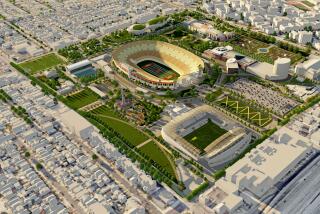Proud Legacy : Park Opens on Site Owned by L.A. Pioneer
- Share via
Robynn and Cheryl Cox couldn’t believe it when they learned that their great-great-great-great-grandmother was a famous Los Angeles pioneer. Neither could classmates at their Culver City elementary school.
But there it was, spelled out for all to see in fourth-grade history books.
A full page was devoted to Biddy Mason, a onetime Mississippi slave who fought to win her freedom and became a major Los Angeles landowner and philanthropist in the late 1800s.
“My friends didn’t believe me when I said, ‘That’s my grandmother!’ ” recalled 11-year-old Robynn. Cheryl, now 13, said: “One girl said if that was true, I’d be rich now.”
But there were no doubts about their family’s rich heritage on Tuesday, when the two girls snipped a ribbon to help open the $900,000 Biddy Mason Park in downtown Los Angeles.
Land at 333 S. Spring St. that Biddy Mason purchased for $250 in 1866 has been turned into a $24-million high-rise parking garage and shopping arcade called the Broadway Spring Center. In the middle is a tree-shaded mini-park and rest area dedicated to Mason.
An 81-foot-long concrete time wall sculpture at the edge of the park traces Mason’s life. It tells of how she was born a slave in 1818, grew up to be a nurse and midwife and then walked across the continent behind her master’s wagon train in 1848.
After meeting freed slaves in San Bernardino, Mason went to court to win her freedom in 1856. For the next 10 years, she saved her wages from her midwife and nursing work to buy property between Spring Street and Broadway.
In the years that followed, “Biddy Mason’s Place” became known as a day-care center and orphanage and as the meeting place for the city’s first African Methodist Episcopal Church. In the 1880s, Biddy Mason financed a disaster center for residents left homeless by flooding.
“I think Biddy Mason saw the possibilities when she came to this site,” Mayor Tom Bradley told 200 people at the park for the ribbon-cutting. “She was a first in so many ways. But today, Biddy Mason comes home to stay.”
James M. Wood, board chairman of the city Community Redevelopment Agency, urged visitors to pay close attention to the replica of Mason’s freedom papers displayed in the park.
“There’s a copy of that court order on the wall. Go look at it. Put your hands on it,” said Wood, whose agency financed the mini-park’s construction.
“Thank God for Biddy Mason. . . . When she won her freedom, she won mine. She stood up straight and said, ‘I ain’t gonna take it no more.’ ”
Although she was a living legend, Mason was all but forgotten after she died in 1891. It wasn’t until 1988 that city officials and members of the AME church she helped establish placed a headstone on her unmarked grave at Evergreen Cemetery in Boyle Heights.
“She’s just now getting famous,” said Gladys Owens Smith, Mason’s 97-year-old great-granddaughter, as she watched Robynn and Cheryl snip the ceremonial ribbon. “It makes you feel good.”
Linda Cox, 41, the pioneer’s great-great-great-granddaughter, said the park reflects a growing awareness of the diverse cultures that have built Los Angeles.
“It took 100 years for Biddy Mason to be recognized, but we walk a lot taller knowing this history,” said Cox, a Santa Monica College instructor and administrator.
Moments after the ribbon was cut, the park was quick to make its mark on visitors.
Broadway Spring Center manager Biff Nelson said the park’s construction wasn’t completed until hours before Tuesday’s ceremony. And the last thing that workers did was paint the park’s steel gates a bright green.
But as they swung open for the first time, the gates brushed against a City Council member and deposited a green smear.
“Great,” Nelson gasped in horror. “We got paint on Rita Walters.”
More to Read
Sign up for Essential California
The most important California stories and recommendations in your inbox every morning.
You may occasionally receive promotional content from the Los Angeles Times.














